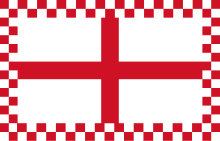 Coat of arms | |
 Company flag (c. 1665) | |
| Formerly | Company of Royal Adventurers Trading to Africa |
|---|---|
| Company type | Private |
| Industry | Mercantile trading |
| Founded | 1660 in London, England |
| Founders | House of Stuart City of London merchants |
| Defunct | 1752 |
Key people | James II of England, Charles II of England |
| Products | Gold, silver, ivory, slaves |
The Royal African Company (RAC) was an English trading company established in 1660 by the House of Stuart and City of London merchants to trade along the West African coast.[1] It was overseen by the Duke of York, the brother of Charles II of England; the RAC was founded after Charles II ascended to the English throne in the 1660 Stuart Restoration, and he granted it a monopoly on all English trade with Africa.[2] While the company's original purpose was to trade for gold in the Gambia River, as Prince Rupert of the Rhine had identified gold deposits in the region during the Interregnum, the RAC quickly began trading in slaves, who became its largest commodity.
Historians have estimated that the RAC shipped more African slaves to the Americas during the Atlantic slave trade than any other company. The RAC also dealt in other commodities such as ivory, which were primarily sourced from the Gold Coast region. After William III of England rescinded the company's monopoly in 1697 under pressure from the Parliament of England, the RAC became insolvent by 1708, though it survived in a state of much reduced activity until 1752, when its assets were transferred to the newly founded African Company of Merchants, which lasted until 1821.[3]
- ^ "The King Grants the Right to Trade in Africa". National Archives. Retrieved 18 August 2020.
- ^ Carrington, Charles (1950). The British Overseas: Exploits of a Nation of Shopkeepers. Cambridge, England: Cambridge University Press. p. 217. OCLC 1083162.
- ^ Jesus College Cambridge Legacy of Slavery Working Party (25 November 2019). Jesus College Legacy of Slavery Working Party Interim Report (July-October 2019) (PDF) (Report). pp. 9–10. Archived from the original (PDF) on 12 March 2021.